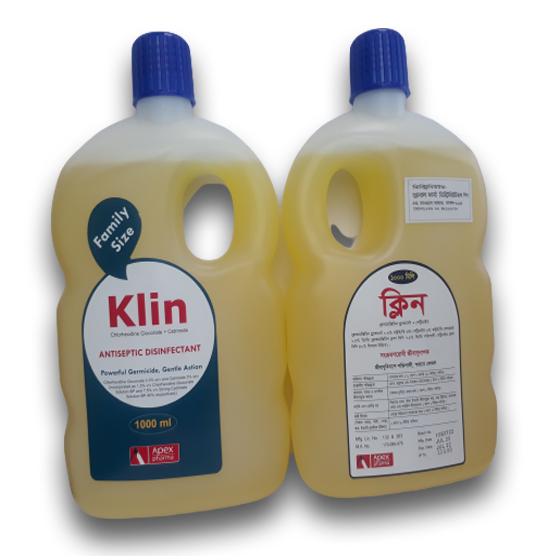Klin Solution
Chlorhexidine Gluconate + Cetrimide

Indications
For cleansing and irrigating the skin and dirty wounds where an added surfactant effect is required.
Pharmacology
Chlorhexidine: Chlorhexidine is an antiseptic and disinfectant which is effective against a wide range of vegetative Gram-positive and Gram-negative organisms, some viruses and some fungi. It is ineffective against bacterial spores at room temperature, and acid-fast bacteria are inhibited but not killed. It is more active against Gram-positive than Gram-negative bacteria and some species of Pseudomonas and Proteus are relatively less susceptible. Chlorhexidine is most active at a neutral or slightly acid pH and its activity may be reduced by blood and other organic matter.
Cetrimide: Cetrimide is a quaternary ammonium disinfectant with properties typical of cationic surfactants. Solutions of these surfactants have emulsifying and detergent properties and bactericidal activity against both Gram-positive and Gram-negative organisms but higher concentrations are necessary to kill the latter. The combined detergent and antibacterial properties of cetrimide make it useful in cleansing dirty or infected wounds. It is however, relatively ineffective against bacterial spores, acid-fast bacteria, viruses and fungi.
Dosage & Administration
Rinse the area to be cleaned with water, apply the minimum amount of irrigation necessary to cover the wound area and wash gently. Rinse again thoroughly. Apply to wound as necessary. Discard remaining solution after use.
Paediatric Use: Use with care in neonates, particularly in premature infants. Chlorhexidine may cause irritation or chemical burns.
* চিকিৎসকের পরামর্শ মোতাবেক ঔষধ সেবন করুন‘
Contraindications
Known hypersensitivity to either chlorhexidine or cetrimide. Do not use to irrigate the brain, meninges, eyes or perforated eardrum.
Side Effects
Irritative skin reactions and hypersensitivity reactions to chlorhexidine have been reported. In the event that these reactions occur, discontinue use. Cetrimide may have a prolonging effect on the wound healing process.
Pregnancy & Lactation
Pregnancy: There are no adequate data from the use of chlorhexidine and cetrimide in pregnant women. The potential risk for humans is unknown but is most likely very low since chlorhexidine and cetrimide are poorly absorbed following topical application.
Breastfeeding: It is not known whether chlorhexidine and cetrimide are excreted in breast milk. There are no adequate data from the use of chlorhexidine and cetrimide in breast-feeding women. However, it is unlikely that the products are excreted in breast milk, since the products are poorly absorbed. After topical usage of the product, as a general precaution, rinse nipples thoroughly with water before breastfeeding.
Precautions & Warnings
For external use only. Not for injection, for irrigation only. Not isotonic and is haemolytic. Cetrimide may have a prolonging effect on the wound healing process. Use of this antiseptic should be restricted to infection control and cleansing of wounds rather than general wound management.
Overdose Effects
While accidental ingestion is unlikely to cause any systemic effects due to poor absorption of chlorhexidine and cetrimide, ingestion of high concentrations could cause irritation of the gastrointestinal mucosa/gastritis. Gastric lavage might be needed. Symptomatic treatment should be employed. If swallowed, wash out mouth, drink plenty of milk or water and seek medical advice. In case of overdose, seek medical attention or contact a poison control centre.
Therapeutic Class
Chlorhexidine & Chloroxylenol preparations
Storage Conditions
Store below 25°C. Protect from light. Single use only. Discard unused portion.
